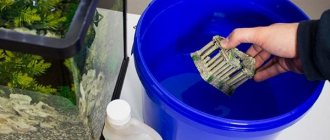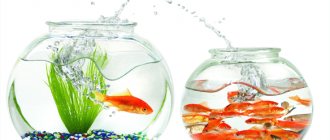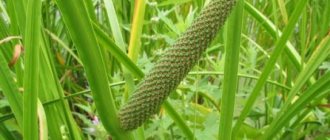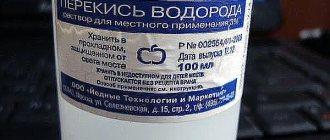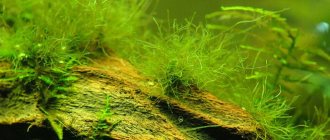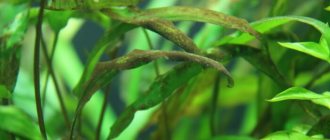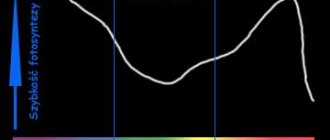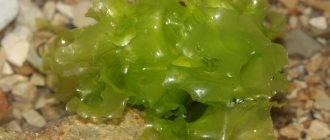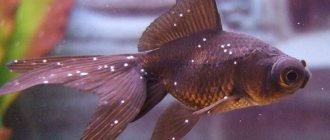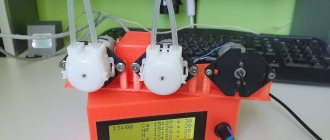If algae appears in your aquarium, be sure to eliminate it. These harmful plants can harm aquatic flora and fauna. The aquarium where they appeared becomes unsightly, the water in it becomes cloudy and acquires a greenish tint. Anything that is immersed in water, including glass, develops a characteristic coating.
Algumin Plus is a good remedy in the fight against water parasites - the instructions for use of the drug provide complete information about it.
Algaecide - description of the substance
Compound
The algaecide contains the main component of this substance - ammonium, and specifically its quaternary compounds, of which about 10% are present in the algaecide. The liquid concentrate does not contain chlorine compounds; the algaecide also does not contain heavy metals and is pH neutral.
Scope of application and principle of operation
Algaecides are used to prevent pollution and purify water in reservoirs, swimming pools, irrigation canals, decorative ponds, etc.
Release form and environmental impact!
| Form | Impact |
| Glutaraldehyde | Disturbance of protein synthesis. Safe for complex plant and animal organisms; positive bacteria. Does not affect algae whose spores do not undergo photosynthesis and lack chlorophyll. |
| Biocide | Together with the destruction of algae, there is a suppression of vital activity and a detrimental effect on beneficial microflora, and if oversaturated, it can destroy. |
| Oxidant (oxidizing agent) | Overlapping of nutrients for algae and higher plants, destruction of microflora. Changes in the chemical parameters of water to a lesser advantage. Due to the rapid rate of decay, an overdose is much more dangerous compared to other substances. |
| Humic compound (acid) | They change phosphates into a form that is inaccessible to vegetation, in other words, they accelerate the aging process of water, for this reason it takes on a transparent color with a yellowish tint. Algae have the greatest need for phosphates in comparison with higher plants - the latter consume the remains and the algae die from starvation. Water is highly oxidized due to humates, so the substance is not suitable for an aquarium with creatures that are demanding of a neutral or slightly alkaline environment. Humates can help treat sick fish, but will suppress its reproductive ability for at least 6 months. |
| Zeolite | Absorption of phosphates from water. Unlike humates, it does not affect the water and quality of life of the aquarium inhabitants. If you follow the one-time use rule, negative effects are excluded. |
| Antibiotic | At the slightest excess of the dose, the mechanism of destruction of microflora and higher relationships is triggered. At the same time, it extremely quickly destroys lower organisms due to its close evolutionary relationship with bacteria. |
Preventing the growth of excess vegetation
To prevent harmful growths from appearing, you need to know about preventive measures. The main ones are:
- Selecting the right location for the aquarium. If direct sunlight hits the water, algae growth is possible.
- Constant water replacement.
- Creating the right growing conditions for plants in the aquarium.
Now we can dwell on the important points in more detail.
Water composition
To stop negative growth, you need to know the composition of the water. The growth of such pests is primarily influenced by sunlight penetration and excess nutrients. To prevent algae from continuing to actively develop, it is necessary to reduce the supply of microelements such as phosphates and nitrates.
Temperature is also important: if the water is warm, algae will begin to multiply. The presence of excess nutrients in the liquid also promotes the growth of parasitic plants. We need to reduce them. Well, the increased rate of decomposition of ammonia NO2, NO3 also contributes to the appearance of harmful vegetation in the aquarium.
Water changes should be regular. But this is not a panacea for the complete destruction of parasitic algae.
Algae-eating animals
There are some algae-eating animals that can help improve the situation. These are daphnia. First, all living creatures are removed from the aquarium and algae eaters are introduced, which in a short time cleanse its contents of parasitic plants.
Fish that feed on algae include:
Siamese algae eater
ancistrus
They may not completely get rid of the problem, but they will take on most of the work. Buy viviparous fish for your aquarium, which, like shrimp, will eat algae, thereby helping the plants to cleanse themselves.
And one last thing. Use chemicals in extreme cases when other control methods have proven ineffective. AlguMin Plus is a reliable and effective tool, but you should not rely on it completely.
It is necessary to systematically care for the aquarium: change the water in a timely manner, test its composition, carry out mechanical cleaning, adjust the aeration and filtration of the container with liquid.
Popular algaecide-based preparations
Non-foaming aquatics
Aquatics' non-foaming algaecide is designed to prevent and kill algae growth in swimming pools without altering the pH level of the water. The product can be used to disinfect showers and bathtubs.
- distinctive property: successful use of Algaecide Aquatics with all types of filtration units, disinfectants and other auxiliary means for water treatment;
- shelf life: up to 5 years;
- container: supplied in cans from 1 to 30 liters;
- method of application: at the beginning of the season with a frequency of one week. Added to the water when the pool filtration system is turned on. It is allowed to increase the dose in case of a high number of visitors or heavy rainfall;
- combined use: with oxidizing drugs.
Dolphin
The drug effectively prevents the growth of algae over a long period of time, removing substances that cause turbidity in the water. Suitable for all types of pools and spas, and can also be used as an aquarium algaecide.
Distinctive properties:
- tasteless and odorless;
- does not create foam;
- minimum amount of harmful substances;
- retains the effect when in contact with heat;
- leaves the acid-base balance of water unchanged.
Technical properties:
- shelf life: up to 3 years;
- container: from 250 ml to 5 liters;
- method of application: applied to the bottom and walls of an empty pool;
- combined use: with all types of compounds containing chlorine.
Aquayer algaecide Co2
Algaecide Aquayer Co2 is unique in that it combines the properties of a highly productive algaecide and pentandial - an organic source of oxygen that has a beneficial effect on the growth of aquarium plants.
Directions for use:
- standard: 1 ml per 25 liters of water per day, as a source of Co2, also for the purpose of preventing algae on a regular basis. 2-4 ml per 25 liters of water per day to combat algae outbreaks. Processing time 1 - week.
- intensive: the cleaning filter turns off to stop the water flow for 30 minutes. After that, the affected surface must be treated with a syringe containing Aquayer co2 algaecide. The procedure is repeated the next day. The average consumption of the product for an area of 10x10 cm is about 2 mm.
Technical properties:
- container: from 250 ml to 10 liters;
- Shelf life: up to 3 years at a temperature of no more than 29 °C;
- use with third-party tools is undesirable.
Amazonia
Amazon algaecide CO2 is a biochemical way of destroying algae with accelerating the growth of ornamental plants. It is a complete alternative to the balloon air system, being an independent source of oxygen with the function of fertilizing plants.
Reviews of the algaecide Amazonia Co2 note inhibition of algae growth by healthier and more active plants, also eliminating film.
Mode of application:
- instructions similar to Co2 algaecide aquayer: Add to water as a source of Co2 - 2 ml of product per 50 liters of water at intervals per day; in case of an algae outbreak, the dose increases to 4-8 ml;
- combined use: not applicable with nutrient substrates, including vermicompost.
Technical properties:
- container: from 60 to 250 ml;
- Shelf life: up to 2 years.
Desalgine
The last representative of the ammonium group of drugs. Highly effective in the fight against protozoa. Does not contain chlorine.
Method of using algaecide according to the instructions for use:
- for preventive purposes, it is applied to the bottom and walls of the pool before filling with water with a concentration of 600 g per 20 liters of water. After the protective film has formed, you need to let it dry for several hours.
Technical properties:
- container: from 250 to 500 ml;
- shelf life: 2 years.
Alga power
The main advantage of this drug: it copes well with freezing without losing useful qualities.
Distinctive properties:
- long term of influence;
- does not change the acid-base balance of water due to a neutral reaction;
- does not contain hazardous substances;
- no harmful effects upon contact with skin.
Application: add the first dose of the drug - 150 ml into a filled pool, in subsequent times the dosage is reduced to 50 ml. After 6 hours, change the water.
Technical properties:
- container: from 2 to 50 l;
- shelf life: 5 years.
Rules of use for algae control
In aquariums
Only aqua algaecides are suitable for removing algae in an aquarium. Copper-based products are toxic and disrupt the balance of microflora. Aqua Algaecide is used for 10 days, completely eliminating algae.
For swimming pools
There are 3 ways to use the drug:
- before launch. The pool area is treated with a product diluted in water;
- normal cleaning. Drugs are added to still clean water;
- Impact cleaning. In case of water contamination, the necessary pH of the water is created and then an algaecide is added.
What about perhydrol?
Hydrogen peroxide (perhydrol) is a widely known superoxidant. Suppression of algae by it begins with a dose of 5 mg/l (5 kg/cubic m) in terms of pure active ingredient. Up to a concentration in water of up to 20 kg/m3. m is safe for humans. The use of cheaper than 3% pharmaceutical 35% technical hydrogen peroxide as an algaecide-oxidant for swimming pools can be economically justified in reservoirs with intense forced circulation. Otherwise, there is no point - it will disintegrate without having time to spread throughout the entire volume of water.
Aquarists sometimes use hydrogen peroxide against algae in concentrations of up to 10 mg/l (shock 15 mg/l), but this is a risky business: the pH of the water changes sharply, and when perhydrol decomposes in water with nitrates, a lot of very toxic ammonia is formed. However, due to the cheapness of the drug and its harmlessness to beneficial microflora, hobbyists do not stop experimenting with hydrogen peroxide as an algaecide for aquariums, see video:
Reviews about the product
Real reviews of auqalter algaecide: consumers note the ease of use of this product. Aquarium enthusiasts share a trick - before using the drug, carry out a procedure that allows you to backwash the filter and then preserve it for a day.
With this approach, the drug receives only good reviews from people who have used it, noting the complete compliance with the process stated in the instructions, which is why the effectiveness of the method + product combination leaves no doubt. In addition to its main function, the product is used to clean tiles and rubber products included in the pool, which it does an excellent job of.
